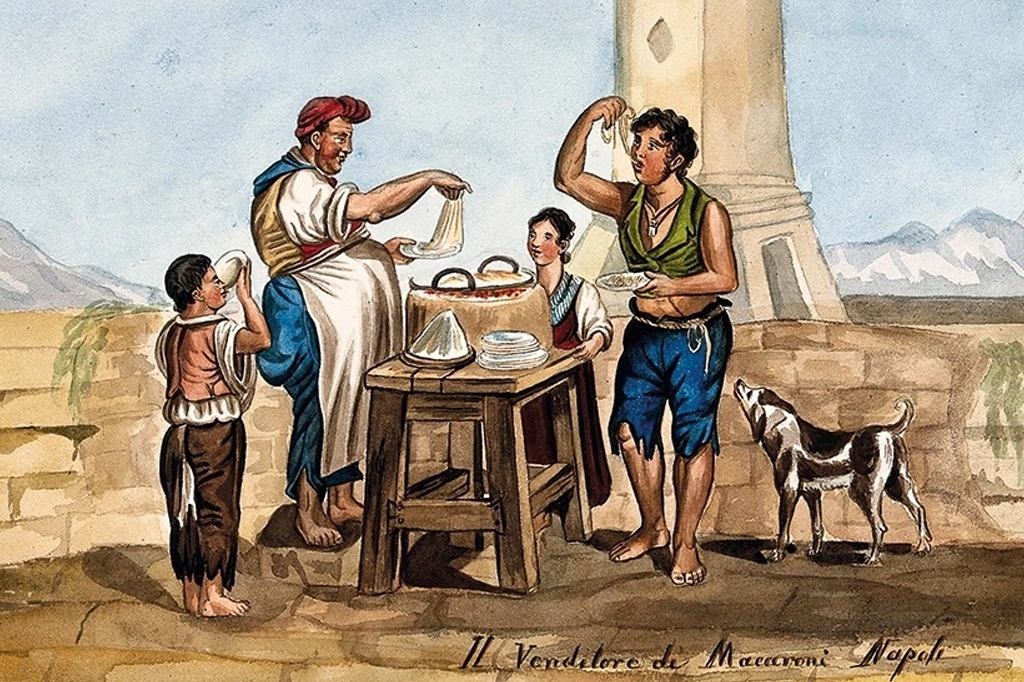A few years ago I was feeling peckish at Catania airport. I wandered over to the main café and spotted — beyond the stacks of panini stuffed with wilting prosciutto — a sign promising pasta. I assumed they’d be doling it out ready-made from a hulking pot, school-canteen style. But no: they were carefully blanching each portion of rigatoni, then finishing it in the sauce (a humble pomodoro). Who cares about foot-tapping customers on the verge of missing their flights? There were more noble priorities.
This national pedantry — more interesting than the British and their tea — has often been mined for comedy. On Instagram you can find reels of vigilante nonnas wincing as some bozo sprinkles parmesan over his spaghetti vongole. And there’s that episode of The Sopranos in which Paulie Walnuts visits the old country and asks for “macaroni and gravy.” For many Italians, though, it’s no laughing matter. In 2015, the celebrity chef Carlo Cracco dared to put a clove of garlic in his amatriciana sauce (basic ingredients: tomatoes, guanciale, chili and pecorino) and was furiously denounced by the region’s municipal government.
So one of the intriguing things about the food historian Luca Cesari’s book, which mentions this incident, is the way it shows that these supposedly unimpeachable rules and “perfect” recipes don’t in fact have a lot to back them up. The Discovery of Pasta touches on the hazy origins of the stuff itself, in classical Greece and the Near East, as well as in twelfth-century Sicily, where it was first dried. But the focus is on how Italians have used it. Over ten chapters, each dealing with one of the big dishes (bolognese, ragù, lasagne and so on), Cesari condenses a library’s worth of cook books and treatises to make the case — perhaps a little too insistently — that pasta is a living thing, changing with the times, rather than ‘some mythical, ahistorical tradition’.
Take, for instance, the question of consistency. The received wisdom is that pasta should be al dente. I’ve served it almost crunchy, to underscore my credentials. Yet overcooked pasta, Cesari points out, was standard in northern Italy — home to the gourmandizing hotbeds of Bologna and Genoa — until the twentieth century. (One book from 1844 advises cooking it for an hour.) And finishing it in the sauce? Well, that only really started in the nineteenth century. Before then, pasta was often just topped with butter and cheese. In the amatriciana origin story — not the only one to involve eighteenth-century shepherds toughing out the winter — garlic may have played no part, yet, according to Cesari, it featured in “almost every recorded recipe from the outset.” And recipes themselves can be questionable sources of authority, he cautions, citing these fifteenth-century instructions for making ravioli:
Seal [the filling] in the pasta so that the ravioli are no bigger than half a chestnut, and put them to cook in capon broth and let them boil for the span of two Our Fathers.
If this is starting to sound like a catalog of “gotcha”s, a carby Pseudodoxia Epidemica, that’s because a fair amount of it is. Cesari has no time for the “pearl clutchers,” as he likes to call them, and he dexterously deploys his sources, stretching from ancient Rome to 1940s Jersey City, to prove them wrong. (Their fussiness, it’s implied, is dangerously close to being French.) This will either be your thing (it happens to be mine) or it won’t.
But Cesari is also perceptive about why Italians became so obsessed with codifying their recipes in the early twentieth century, when people worried that industrialization was destroying their connection to the past. I was reminded of how, at a similar time, English composers such as Vaughan Williams went around collecting old folk songs.
He’s good, too, on pasta’s relationship with wider Italian culture, discussing its appearance in Boccaccio (who imagines “a mountain made wholly of grated Parmesan cheese, on which dwelt people who did nothing but make macaroni and ravioli”), along with a moment in the 1950s when the coolest thing any celebrity could do was to eat carbonara in Rome. (On a publicity trip, Oliver Hardy saw off five plates in one go.) And while I’m not sure the book entirely fulfills its promise to explain how pasta “shaped the world,” Cesari does show how modern tinning technology allowed tomatoes (and thus spaghetti al pomodoro) to be exported across the globe, putting Italian cuisine decisively on top — even if the Americans did unspeakable things with it.
Still, the case for a pluralistic approach to pasta is made most persuasively by the sheer number of recipes and variations on them I now want to try. Deliciousness abounds in this book. Renaissance tortelletti, anyone? — though I might leave out the cow udder, if that’s all right.
This article was originally published in The Spectator’s UK magazine. Subscribe to the World edition here.

























